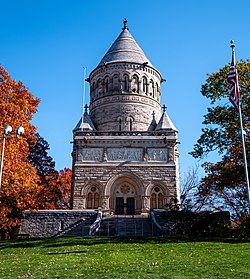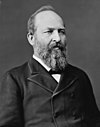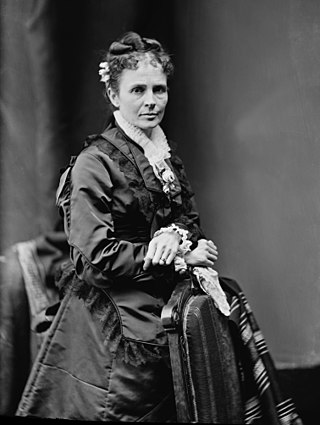
Lucretia Garfield was the first lady of the United States from March to September 1881, as the wife of James A. Garfield, the 20th president of the United States.

James Rudolph Garfield was an American lawyer and politician. Garfield was a son of President James A. Garfield and First Lady Lucretia Garfield. He served as Secretary of the Interior during President Theodore Roosevelt's administration.

Charles Henry Niehaus was an American sculptor.

Caspar Buberl was an American sculptor. He is best known for his Civil War monuments, for the terra cotta relief panels on the Garfield Memorial in Cleveland, Ohio, and for the 1,200-foot (370 m)-long frieze on the Pension Building in Washington, D.C.

James A. Garfield National Historic Site is a United States National Historic Site located in Mentor, Ohio. The site preserves the Lawnfield estate and surrounding property of James A. Garfield, the 20th president of the United States, and includes the first presidential library established in the United States.
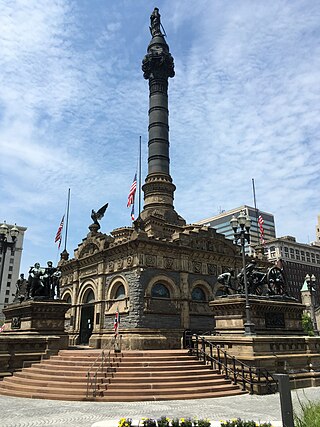
The Cuyahoga County Soldiers' and Sailors' Monument is a major Civil War monument in Cleveland, Ohio, honoring the more than 9,000 individuals from Cuyahoga County who served the Union throughout the war. It was dedicated on July 4, 1894, and is located on the southeast quadrant of Public Square in Downtown Cleveland. It was designed by architect and Civil War veteran Levi Scofield, who also created the monument's sculptures. The monument is regularly open to the public, free of charge.

Cleveland, Ohio was an important Northern city during the American Civil War. It provided thousands of troops to the Union Army, as well as millions of dollars in supplies, equipment, food, and support to the soldiers. The city was also an important national center for the abolitionist movement.
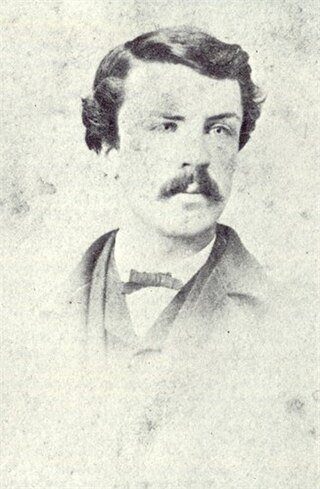
George Keller was an American architect and engineer. He enjoyed a diverse and successful career, and was sought for his designs of bridges, houses, monuments, and various commercial and public buildings. Keller's most famous projects, however, are the Soldiers and Sailors Memorial Arch in Hartford, Connecticut, and the James A. Garfield Memorial in Cleveland, Ohio.
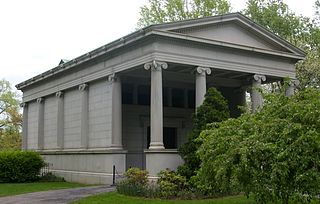
Wade Memorial Chapel is a Neoclassical chapel and receiving vault located at Lake View Cemetery in Cleveland, Ohio, in the United States. It was donated to the cemetery by Jeptha Wade II in memory of his grandfather, cemetery and Western Union co-founder Jeptha Wade. The overall design was by the newly-founded Cleveland area architectural firm of Hubbell & Benes, and was their first commission. The interior's overall design is by Louis Comfort Tiffany based on a preexisting 1893 design. The interior features two mosaics on the right and left hand walls, and a large stained glass window.

Worthy Stevens Streator was an American physician, railroad developer, industrialist and entrepreneur after whom the city of Streator, Illinois, is named. He was instrumental in the creation of the Atlantic and Great Western Railway in Ohio, was president of the Baltimore and Ohio Railroad (B&O), and financed the first large-scale coal mine operation in Northern Illinois in 1866. He served as an Ohio State Senator from 1870 to 1872, and was the first mayor of East Cleveland, Ohio. He was an influential in the development of many civic institutions in his home city of Cleveland, Ohio. He co-founded the Christian Standard magazine, he was an original endower of Case School of Applied Science and was a principal in the creation of the James A. Garfield Monument; the first true mausoleum created in the United States in honor of President James A. Garfield. He was a pallbearer at President Garfield's funeral in 1881.

Calvary Cemetery is a Roman Catholic cemetery in Cleveland, Ohio, in the United States. The cemetery straddles the border between Cleveland and the city of Garfield Heights, with its offices within the city limits of Cleveland. Calvary Cemetery is the largest Catholic cemetery in Cleveland, and one of the largest in Ohio.

This article is a timeline of the history of the city of Cleveland, Ohio, USA.
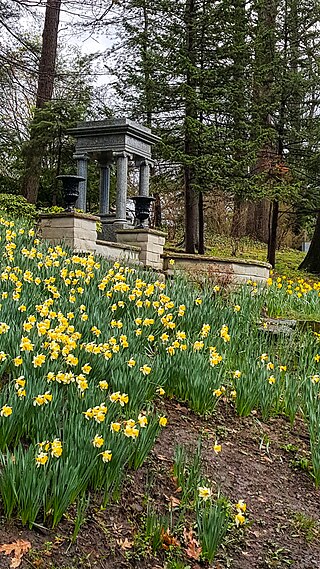
Lake View Cemetery is a privately owned, nonprofit garden cemetery located in the cities of Cleveland, Cleveland Heights, and East Cleveland in the U.S. state of Ohio. Founded in 1869, the cemetery was favored by wealthy families during the Gilded Age, and today the cemetery is known for its numerous lavish funerary monuments and mausoleums. The extensive early monument building at Lake View helped give rise to the Little Italy neighborhood, but over-expansion nearly bankrupted the burial ground in 1888. Financial recovery only began in 1893, and took several years. Lake View grew and modernized significantly from 1896 to 1915 under the leadership of president Henry R. Hatch. The cemetery's cautious management allowed it to avoid retrenchment and financial problems during the Great Depression.

Knollwood Cemetery is a cemetery located at 1678 SOM Center Road in Mayfield Heights, Ohio. Established in 1908, it is one of the largest cemeteries in Cuyahoga County. A mausoleum was completed in 1926, and an expansion finished in 1959. The cemetery's mausoleum, the largest in the state, boasts a number of windows by Tiffany & Co.

Woodland Cemetery is a historic rural cemetery located at 6901 Woodland Avenue in Cleveland, Ohio. Established in 1853, it became Cleveland's main public cemetery after its founding and remained so for the next half-century. It fell into extreme disrepair, and most of its outstanding architectural features dismantled or demolished. In 1986, Woodland Cemetery was added to the National Register of Historic Places. The cemetery has since undergone restoration.

Henry Chisholm was a Scottish American businessman and steel industry executive during the Gilded Age in the United States. A resident of Cleveland, Ohio, he purchased a small, struggling iron foundry which became the Cleveland Rolling Mill, one of the largest steel firms in the nation. He is known as the "father of the Cleveland steel trade".

The Cleveland Foundation Centennial Lake Link Trail, originally known as the Lake Link Trail, is a cycling, hiking, and walking trail located in the city of Cleveland, Ohio, in the United States. Owned by the city of Cleveland and maintained by Cleveland Metroparks, the trail runs along the former track bed of the Cleveland and Mahoning Valley Railroad. The trail is named for The Cleveland Foundation, a local community foundation which donated $5 million toward the trail's construction. The southern leg of the 1.3-mile (2.1 km) trail opened in August 2015, and the northern leg in August 2017. The middle leg will begin construction once the Irishtown Bend hillside is stabilized. A bridge connecting the trail to Whiskey Island will begin construction in Spring 2019 and will be completed in early Summer 2020.

The Cleveland and Mahoning Valley Railroad (C&MV) was a shortline railroad operating in the state of Ohio in the United States. Originally known as the Cleveland and Mahoning Railroad (C&M), it was chartered in 1848. Construction of the line began in 1853 and was completed in 1857. After an 1872 merger with two small railroads, the corporate name was changed to "Cleveland and Mahoning Valley Railroad". The railroad leased itself to the Atlantic and Great Western Railway in 1863. The C&MV suffered financial instability, and in 1880 its stock was sold to a company based in London in the United Kingdom. A series of leases and ownership changes left the C&MV in the hands of the Erie Railroad in 1896. The CM&V's corporate identity ended in 1942 after the Erie Railroad completed purchasing the railroad's outstanding stock from the British investors.
The Monroe Street Cemetery is a historic cemetery located at 3207 Monroe Avenue in Cleveland, Ohio. It was designated a historic landmark by the City of Cleveland Landmarks Commission in 1973.
